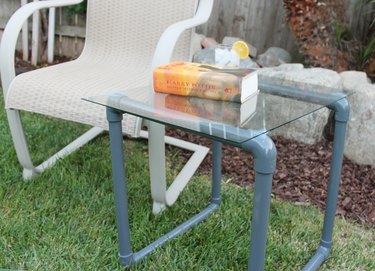A side table made with PVC pipe makes an unexpected yet stylish addition to your seating area and is suitable for both indoor and outdoor spaces. You can build your own with very little effort and customize the dimensions to fit your space. Painting the pipe gives the table a modern industrial look.
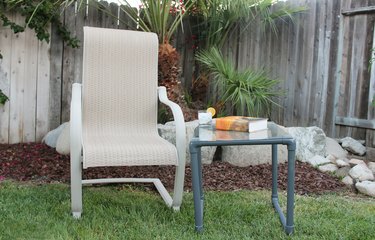
Video of the Day
Things You'll Need
10-foot PVC pipe, 1
Measuring tape
PVC pipe cutter
Medium clear PVC cement
90-degree PVC angles, 8
Metallic finish spray paint (optional)
Caulking gun
All-purpose weatherproof silicon clear sealant
18-by-24-inch glass piece
Step 1
Start by gathering your supplies and cutting all of the PVC pipes. Use the PVC pipe cutter to cut eight 10-inch PVC pipe pieces. Make sure to wipe the pipes clean of any debris or dirt after cutting.
Video of the Day
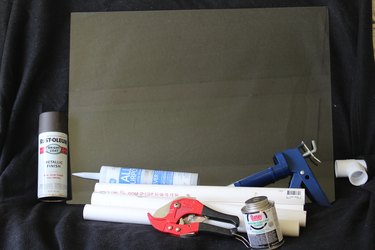
Step 2
Take one of the 10-inch pieces of PVC and attach a 90-degree PVC angle to it with PVC cement. Make sure the pipe goes in as far as it can. Now, attach another pipe to the other side of the 90-degree angle. Add a 90-degree PVC angle to the end of the second pipe, making sure the two 90-degree angles are facing each other and the pipes can lay flat. Now add a third pipe to the open end of the 90-degree angle. You should almost have a square at this point when laying the pipes flat.

Tip
Each time you connect a piece of pipe to a 90-degree PVC angle, you need to apply PVC cement to the inside of the 90-degree piece and also on the outside of the pipe, about 1/2 inch on both. After connecting each piece, be sure to wipe away any excess glue with a paper towel.
Step 3
With the pipes you just pieced together laying flat on the ground, attach 90-degree PVC angles to the open ends of the two pipes so that the open ends of the 90-degree angles are facing up (as shown).
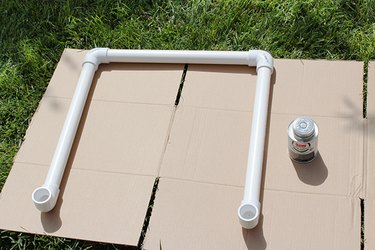
Tip
Before moving on to the next step, you can place two pipes into the open ends of the 90-degree angles (without glue) to make sure they are level before the glue dries on the angles.
Step 4
Attach two more pipes to the open ends of the 90-degree angles. Now, attach two more 90-degree angles, but have the open ends facing inward toward the direction of the pipes on the ground.
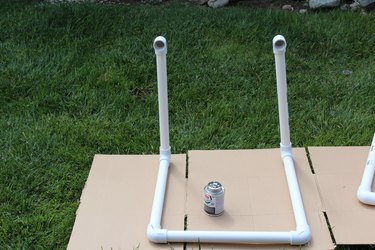
Step 5
Attach two more pipes to the open ends of the 90-degree angles. Attach the remaining two 90-degree angles to the open ends of the pipes. Have the two 90-degree angles face each other before adding the last pipe to connect everything together, finishing off the base of the table.
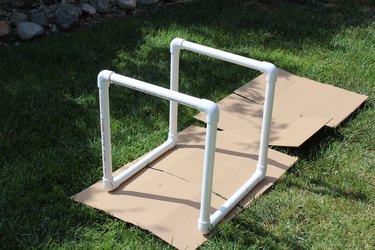
Step 6
Now that all of the pipes are connected, you have the option of spray painting the PVC. Be sure all of the cement is dry before spray painting. For a more industrial look, use a dark metallic spray paint (shown here).
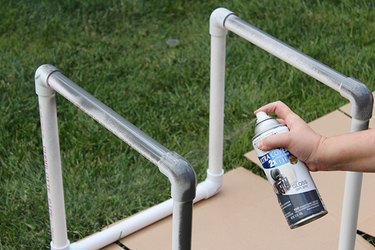
Step 7
Once the spray paint is completely dry, stand your table base upright. Place the silicon clear sealant in the caulking gun and apply a penny-sized amount of sealant to the top four corners of your table base (make sure to follow any directions on the sealant packaging before placing into the caulking gun). Now place your glass piece evenly on top of the table base. If you are working on an uneven surface, the glass may slide off, so be careful. The silicon clear sealant takes about 12 hours to dry and become completely weather-resistant. It will still be slightly visible after it dries.
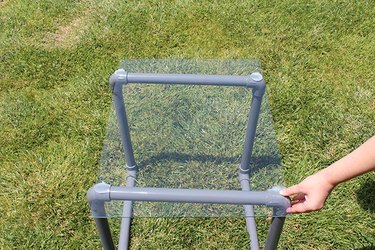
Tip
Substitute a same-sized piece of plywood for the glass piece if you would prefer a wood tabletop. You can paint or stain that as well to complete your industrial look.
Pair your table with a chair outside for a cozy reading nook or arrange it indoors as a modern end table.
